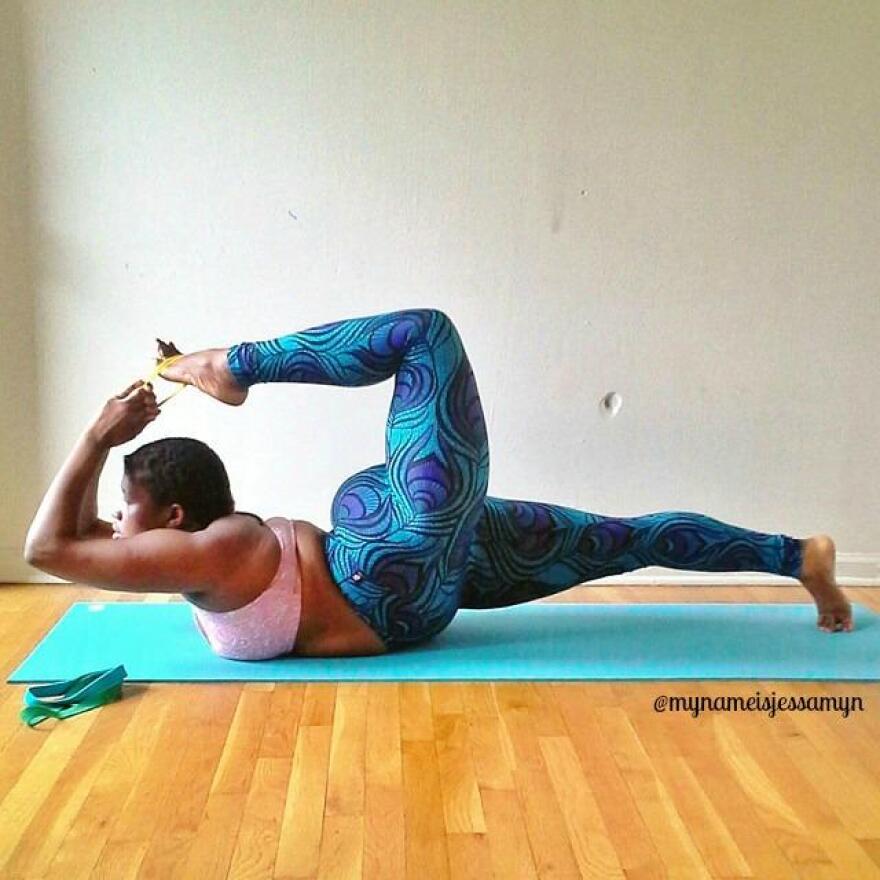Images of women’s bodies are now more prolific than ever. From media advertisements to fitness blogs and Facebook feeds, photos of women’s bodies are everywhere.
There have been ongoing conversations in academia and popular culture about the impact that these images have on body image, but a growing chorus of women argue that there has long been something missing in this conversation: fat bodies can be healthy and beautiful, and fat shaming benefits no one.
A "Fat Femme" on Instagram
Jessamyn Stanley calls herself a "fat femme." She has gained national prominence for her Instagram feed documenting her yoga progression and now teaches yoga in Durham, NC. She said she started bikram yoga as a teenager but did not enjoy it. She swore she wouldn’t do it again, but several years later in graduate school, a friend got her to try it out one more time .
“I did try it against my better judgment,” Stanley said. “I was going through a rough time. It was a really, really dark time and yoga was exactly what I needed. It was the therapy I did not know was possible. It was better than medicine.”
'I got messages from people like, 'Wow I did not know a fat girl could do blank kind of pose. I was like, 'How did you not know this?''
As she grew in yoga, she started to post pictures of her poses on Instagram to get tips and feedback from the online community. But then she started receiving comments she did not expect.
“I got messages from people like, ‘Wow I did not know a fat girl could do blank kind of pose.’” Stanley said. “I was like, 'how did you not know this?'”
As she talked to more people, she learned many people felt they were not designed for yoga.
“They literally think they could never practice yoga because the western media positions yoga in such a place where it’s only accessible to wealthy, thin, educated, white women,” Stanley said.
There is a widely held belief in society that heavier people are not healthy, but Stanley disagrees. She points to her ability to do headstands as a great indication of her core strength.
“They’re just mad because they see something that is the opposite of what they’ve been taught to believe their whole life,” Stanley said. “It’s not like I have people creeping at my doctor’s office looking at my facts and figures.”
Part of the problem, Stanley says, is the institutionalized way women talk to each other.
“Women say so much terrible stuff about themselves and about each other and it’s creating that toxic dialogue that when you see girls are suicidal or cutting themselves, and you wonder why they’re so depressed,” Stanley said. “Because their mothers and sisters and all of these people are just reinforcing this dialogue.”

Where Does This "Self-Scrutiny" Come From?
Author, blogger and humorist Brittany Gibbons shared some of Stanley's perspective. She started blogging several years ago about the less glamorous parts of parenthood, and recently released the memoir “Fat Girl Walking: Sex, Food, Love, and Being Comfortable in Your Skin…Every Inch of It” (Harper Collins/ 2015).
Early on, Gibbons carefully cultivated her online image and cropped pictures or manipulated photos to keep her plus-size shape out of view of her readers.
But one day, a reader saw an image and "outed" Gibbons as plus-sized. The comment devastated Gibbons, but not nearly as much as seeing her 4 year-old daughter sucking in her stomach in the mirror. She was emulating Gibbons’ daily habits.
“She had done it not realizing what she was doing,” Gibbons said. “It was horrifying to me that I had reflexively taught her what she thinks is a normal way to address her body.”

This sort of scrutiny is relatively new to society. Professor Joan Jacobs Brumberg traces 100 years of girls' personal diaries in her book “The Body Project” (Vintage/1998). Brumberg argues that until mirrors and electric lights, the level of self-scrutiny with women was not that high. By the end of the 19th century, handheld mirrors were becoming popular. The proliferation of scales after World War II also raised the bar of self-scrutiny.
Brumberg said women just instinctively talk about weight and body image now.
“They do it reflexively,” Brumberg said. “They always notice if you’ve lost weight or if you’ve gained weight. That’s something we could stop doing.”
Where Unhealthy Body Image Lies Today
“The pediatricians of America are armed with their figures on normative size these days,” Brumberg said about the United States' war on obesity. “They do BMI's on little kids, I understand, in the state of Texas to determine if they’re fat.”
UNC psychology professor Anna Bardone-Cone added there are clear messages today on what it means to be fat or skinny.
“It’s not just attractiveness,” Bardone-Cone said. “Thin people are seen as being more in control, being more successful, being happier and fat people perhaps laziness, less smart. There is this pull to think being fat is the worst thing to happen.”
Television shows like “The Biggest Loser” fat shame people into losing weight.
“Plus size people have become such villains in society,” Gibbons said. “We’re often blamed for rising healthcare costs and all that comes along with that. I just find a sense of ickiness that comes with watching a show where getting to their weight, we ask for a pound of fat in the form of shame.”
Watch Brittany's TED Talk:







